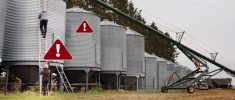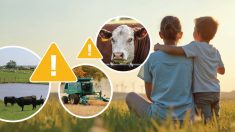A federal investment of $3.4 million over five years in the Canadian Agricultural Safety Association (CASA) will fund more farm safety training and monitoring progress towards safer farms, officials said here last week.
The funds support CASA efforts to implement the Canada FarmSafe Plan as well as initiatives such as annual national agricultural safety weeks held each March.
Federal Minister of State for Social Development Candice Bergen shared details of the funding, which is through the Fostering Business Development Stream of AgriCompetitiveness — a $114-million program under Growing Forward 2 — here last week.
Read Also

Finally getting paid for sustainable farming?
Alberta project says they might have a line on a workable ecosystem credit model to reward farmers for sustainability, and Manitoba might be next
“Farm safety is a critical part of risk management for farmers,” Bergen said while speaking to reporters at Greenland Equipment in Carman. “Our government takes farm safety very seriously.”
Yet, while the rate of fatalities and injuries is decreasing, Canada cannot have a competitive industry without more improvements to its farm safety record, she said.
“In 2012, 25 farming workers lost their lives, and 15 were related to farm equipment,” she said. “Those numbers are too big. And there are many more injuries that affect people’s lives.”
CASA, headquartered in Winnipeg, co-ordinates, develops and leads national initiatives to help farmers, their families and workers recognize and manage safety risks.
The funds will go towards programs aimed at injury reduction, said executive director Marcel Hacault.
The funds will target the country’s ongoing agricultural surveillance program, the Canadian Agricultural Injury Reporting (CAIR), which is tracking trends in where injuries occur and where farm safety education needs focus, he said. Also to continue is a major initiative towards farm safety education of rural youth through Progressive Agricultural Safety Days. Since 2002 the program has reached over 69,000 children and other participants.
CASA will also be able to put the Canada FarmSafe Plan in front of more farmers, he said.
From the Grainews website: Skating on thin ice
The business risk-management tool helps farmers write and implement health and safety plans for their operations. Farmers and students in Alberta, Manitoba, Ontario, Quebec and Nova Scotia have been introduced to the plan and farmers are using components of the plan to identify hazards on their farms, Hacault said.
But the last Farm Credit Canada survey on uptake of the plan shows there’s still a long ways to go. It showed while most Canadian farmers (85 per cent) flag safety as their priority, only nine per cent actually had a written safety plan. Another survey this year will determine if those numbers are changing, Hacault said.
“That is the million-dollar question,” he said.
The theme for the upcoming farm safety week March 9 to 15 is ‘Let’s Talk about It’ and will feature producers’ stories about both injuries they’ve experienced as well as things done to prevent them.
“We’ve also developed resources for farmers that will help them conduct safety meetings and explore topics like talking to your kids about safety or overcoming language and cultural barriers with migrant workers,” Hacault said. “The idea is to get people talking about farm safety as a first step towards a safer, more successful farm.”
















